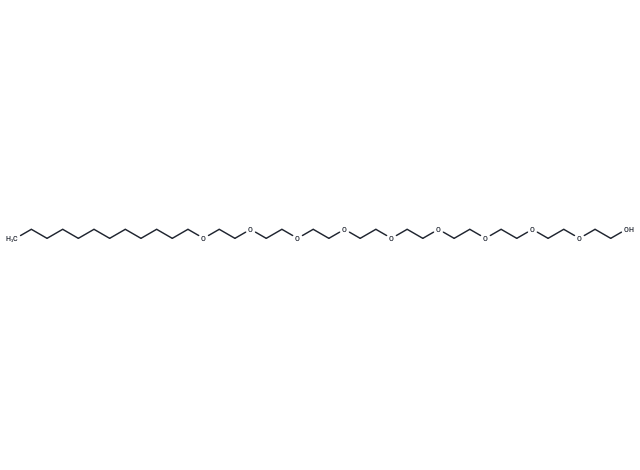Shopping Cart
Remove All Your shopping cart is currently empty
Your shopping cart is currently empty
Nonaethylene glycol monododecyl ether (Polidocanol) is a nonionic surfactant and polyethylene glycol (PEG) detergent. It can be used to form initial coalesced O/W emulsion droplets and for protein separation and purification.

| Pack Size | Price | USA Warehouse | Global Warehouse | Quantity |
|---|---|---|---|---|
| 1 g | $29 | Inquiry | Inquiry | |
| 1 mL x 10 mM (in DMSO) | $39 | Inquiry | Inquiry |
| Description | Nonaethylene glycol monododecyl ether (Polidocanol) is a nonionic surfactant and polyethylene glycol (PEG) detergent. It can be used to form initial coalesced O/W emulsion droplets and for protein separation and purification. |
| In vitro | In vitro incubations with Nonaethylene glycol monododecyl ether typically gave chain lengths that corresponded to those of the isoprenoid moieties in respiratory quinones synthesized in vivo, it displayed by examination of a series of non-ionic PEG detergents with several long-chain E-PDSs from different organisms [2]. |
| Synonyms | Polidocanol, Nonaoxyethylene monododecyl ether |
| Molecular Weight | 582.81 |
| Formula | C30H62O10 |
| Cas No. | 3055-99-0 |
| Smiles | CCCCCCCCCCCCOCCOCCOCCOCCOCCOCCOCCOCCOCCO |
| Relative Density. | 1.007 g/cm3 at 20℃ |
| Storage | Powder: -20°C for 3 years | In solvent: -80°C for 1 year | Shipping with blue ice/Shipping at ambient temperature. | |||||||||||||||||||||||||||||||||||
| Solubility Information | DMSO: 250 mg/mL (428.96 mM), Sonication is recommended. | |||||||||||||||||||||||||||||||||||
| In Vivo Formulation | 10% DMSO+40% PEG300+5% Tween-80+45% Saline: 3.3 mg/mL (5.66 mM), Sonication is recommeded. Please add the solvents sequentially, clarifying the solution as much as possible before adding the next one. Dissolve by heating and/or sonication if necessary. Working solution is recommended to be prepared and used immediately. The formulation provided above is for reference purposes only. In vivo formulations may vary and should be modified based on specific experimental conditions. | |||||||||||||||||||||||||||||||||||
Solution Preparation Table | ||||||||||||||||||||||||||||||||||||
DMSO
| ||||||||||||||||||||||||||||||||||||
| Size | Quantity | Unit Price | Amount | Operation |
|---|

Copyright © 2015-2025 TargetMol Chemicals Inc. All Rights Reserved.